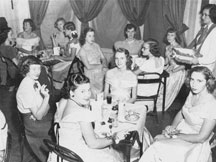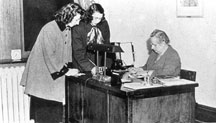
One sunny afternoon in the late 1970s, a Madison alumna was visiting campus for the first time since she graduated many, many years before.
She was flabbergasted by the changes she saw in her alma mater: the presence of men, all those new buildings, a football team, and – my, my – look what the students are wearing these days.
The alumna figured, however, there had to be a semblance of consistency in the midst of all this change. When she met President Ronald E. Carrier, she asked: “Tell me, Dr. Carrier, are the girls still required to wear hose for the evening meal?”
“Not really,” the president answered, “we're lucky to get them to wear shoes.”
Changes at James Madison University have been vast since Nannie Sword of Lee County arrived on campus in September of 1909 as the State Normal and Industrial School for Women's first student.
Among all those changes, however, none can approach the enormous transformation that has taken place in social regulations and traditions.
Today's students have virtually free rein to do whatever they want within the bounds of decency, legality and public safety. On the other hand, students of the 1920s were faced with non-bendable rules that dictated, among other things:
“Young men from Harrisonburg and vicinity must submit recommendations and be approved by the Dean of Women or President of the college before being permitted to call on students.”
“There shall be no reading or studying anywhere after the room lights are turned out . . . by 10:30 every night.”
“Students in groups of three or more are allowed the privilege of walking before 6 p.m. for recreation a mile from campus provided they return to the campus within at least two hours.”
“Students shall wear hats in the business sections of town during the day.”
“Students are not allowed to dance in any public place; neither are they allowed to dance in the private homes in the city of Harrisonburg . (Faculty homes excepted.)”
“No . . . student of the college is permitted to ride in an automobile or other conveyance without first securing permission from the Dean of Women . . .”
 |
|---|
The rules loosened up a good bit but many regulations that seem archaic today hung on until the 1970s. Well into the 1960s, for example, there were still strict rules on dating – freshmen had to meet their dates in Alumnae Hall and there were firm hours for returning from dates. Even walking on the grass – “cutting campus” – was a strict no-no and a punishable offense.
Through the years, students rarely acquiesced quietly to the rules they considered Draconian. There have been decades of protests, complaining and plain old grumbling.
The first formal protest the school ever saw was probably the “May Revolt” of 1941. Students were miffed over rules relating to dating. At the time, freshmen and sophomores were allowed only five minutes to walk from a dance in Reed Hall (now Keezell Hall) to Alumnae Hall and tell their dates good-night. Members of the Student Council, on orders of the dean of women, were standing guard to make sure there were no good-night kisses. The dean of women was even known to appear in the hall and blow a whistle when the five minutes were up.
On the Monday following the May Day dance, members of the freshman class assembled in Ashby gym and vowed to stay there until changes were made in social regulations. There was talk of a march on Hillcrest, a meal strike and a boycott of classes. Finally some upperclass student leaders talked the freshmen into disbanding and giving a committee time to meet with representatives of the administration.
In the 50s and 60s, students grumbled about rules of the day. Particularly onerous was the no-Bermuda shorts rule. (Shorts could only be worn underneath raincoats.) In the early 1970s, coinciding with the general protest mood on American college campuses, Madison students protested “academic freedom” and a multitude of social regulations.
By the late 1980s, the complaint was over the banning of beer kegs from dorms. The bulk of the grousing from today's students also relates to rules dealing with alcohol consumption. There are no fewer than 20 regulations in the current student handbook that deal with alcohol violations.
In the 1920s, however, there wasn't a single word in the student handbook about alcohol. It was beyond belief back then that any student would even harbor such an outrageous thought.
-- Fred Hilton
Madison Magazine
Winter, 2007, Issue
